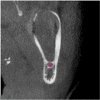Multidisciplinary approach to Gorlin-Goltz syndrome: from diagnosis to surgical treatment of jawbones
- PMID: 35843976
- PMCID: PMC9288940
- DOI: 10.1186/s40902-022-00355-5
Multidisciplinary approach to Gorlin-Goltz syndrome: from diagnosis to surgical treatment of jawbones
Abstract
Background: Gorlin syndrome, also known as Gorlin-Goltz syndrome (GGS) or basal cell nevus syndrome (BCNS) or nevoid basal cell carcinoma syndrome (NBCCS), is an autosomal dominant familial cancer syndrome. It is characterized by the presence of numerous basal cell carcinomas (BCCs), along with skeletal, ophthalmic, and neurological abnormalities. It is essential to anticipate the diagnosis by identifying the pathology through the available diagnostic tests, clinical signs, and radiological manifestations, setting up an adequate treatment plan.
Main body: In the first part, we searched recent databases including MEDLINE (PubMed), Embase, and the Cochrane Library by analyzing the etiopathogenesis of the disease, identifying the genetic alterations underlying them. Subsequently, we defined what are, to date, the major and minor clinical diagnostic criteria, the possible genetic tests to be performed, and the pathologies with which to perform differential diagnosis. The radiological investigations were reviewed based on the most recent literature, and in the second part, we performed a review regarding the existing jawbone protocols, treating simple enucleation, enucleation with bone curettage in association or not with topical use of cytotoxic chemicals, and "en bloc" resection followed by possible bone reconstruction, marsupialization, decompression, and cryotherapy.
Conclusion: To promote the most efficient and accurate management of GGS, this article summarizes the clinical features of the disease, pathogenesis, diagnostic criteria, differential diagnosis, and surgical protocols. To arrive at an early diagnosis of the syndrome, it would be advisable to perform radiographic and clinical examinations from the young age of the patient. The management of the patient with GGS requires a multidisciplinary approach ensuring an adequate quality of life and effective treatment of symptoms.
Keywords: Basal cell carcinoma; Enucleation; Gorlin-Goltz syndrome; Marsupialization; Odontogenic keratocysts; Palm-plantar pits; Protein patched homolog 1; “En bloc” resection.
© 2022. The Author(s).
Conflict of interest statement
The authors declare that they have no competing interests.
Figures





Similar articles
-
Recurrent Metastatic Basal Cell Carcinomas of the Face in a Patient with Gorlin-Goltz Syndrome.Curr Oncol. 2025 Mar 26;32(4):193. doi: 10.3390/curroncol32040193. Curr Oncol. 2025. PMID: 40277750 Free PMC article.
-
[Skeletal and dermatological manifestations of the nevoid Basal cell carcinoma syndrome (Gorlin-Goltz syndrome). Results of 8 patients in 12 years].Rofo. 2007 Jun;179(6):618-26. doi: 10.1055/s-2007-963117. Epub 2007 May 9. Rofo. 2007. PMID: 17492539 Review. German.
-
Gorlin-Goltz Syndrome - A Rare Case Entity in Young Child.Prague Med Rep. 2024;125(1):69-78. doi: 10.14712/23362936.2024.7. Prague Med Rep. 2024. PMID: 38470440
-
Delayed Diagnosis of Gorlin-Goltz Syndrome: The Importance of the Multidisciplinary Approach.J Craniofac Surg. 2018 Sep;29(6):e530-e531. doi: 10.1097/SCS.0000000000004438. J Craniofac Surg. 2018. PMID: 29521748
-
Dental, dermatological and radiographic findings in a case of Gorlin-Goltz Syndrome: report and review.Pan Afr Med J. 2017 Jun 7;27:96. doi: 10.11604/pamj.2017.27.96.12025. eCollection 2017. Pan Afr Med J. 2017. PMID: 28819517 Free PMC article. Review.
Cited by
-
Radiological evaluation of odontogenic keratocysts in patients with nevoid basal cell carcinoma syndrome: A review.Saudi Dent J. 2023 Sep;35(6):614-624. doi: 10.1016/j.sdentj.2023.05.023. Epub 2023 May 30. Saudi Dent J. 2023. PMID: 37817779 Free PMC article. Review.
-
Recurrent Metastatic Basal Cell Carcinomas of the Face in a Patient with Gorlin-Goltz Syndrome.Curr Oncol. 2025 Mar 26;32(4):193. doi: 10.3390/curroncol32040193. Curr Oncol. 2025. PMID: 40277750 Free PMC article.
-
Navigating Beyond a Cyst: The Intricate World of Gorlin Goltz Syndrome - A Case Report.Ann Maxillofac Surg. 2025 Jan-Jun;15(1):98-101. doi: 10.4103/ams.ams_2_24. Epub 2025 Mar 18. Ann Maxillofac Surg. 2025. PMID: 40765868 Free PMC article.
-
Understanding Nevoid Basal Cell Carcinoma Syndrome (Gorlin Syndrome): A Case Report.Cureus. 2023 Mar 22;15(3):e36537. doi: 10.7759/cureus.36537. eCollection 2023 Mar. Cureus. 2023. PMID: 37090309 Free PMC article.
-
Mutations of PTCH1 gene in two pedigrees with bifid rib-basal cell nevus-jaw cyst syndrome.Zhejiang Da Xue Xue Bao Yi Xue Ban. 2023 Apr 25;52(2):223-229. doi: 10.3724/zdxbyxb-2022-0492. Zhejiang Da Xue Xue Bao Yi Xue Ban. 2023. PMID: 37283107 Free PMC article. Chinese, English.
References
-
- Spiker AM, Troxell T and Ramsey ML (2022) Gorlin Syndrome. StatPearls Publishing In: StatPearls [Internet]. Treasure Island (FL): StatPearls Publishing. Bookshelf ID: NBK430921 - PubMed
Publication types
LinkOut - more resources
Full Text Sources
Research Materials
